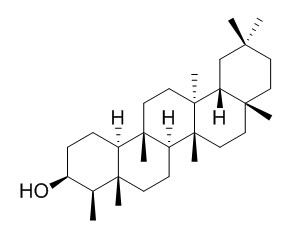Epifriedelanol
Epifriedelanol has antitumor activity, it can reduce cellular senescence in human primary cells and may be used to develop dietary supplements or cosmetics that modulate tissue aging or aging-associated diseases. Epifriedelanol exhibits significant inhibition of NF-kappa B, it may be used to treat asthma.
Inquire / Order:
manager@chemfaces.com
Technical Inquiries:
service@chemfaces.com
Tel:
+86-27-84237783
Fax:
+86-27-84254680
Address:
1 Building, No. 83, CheCheng Rd., Wuhan Economic and Technological Development Zone, Wuhan, Hubei 430056, PRC
Providing storage is as stated on the product vial and the vial is kept tightly sealed, the product can be stored for up to
24 months(2-8C).
Wherever possible, you should prepare and use solutions on the same day. However, if you need to make up stock solutions in advance, we recommend that you store the solution as aliquots in tightly sealed vials at -20C. Generally, these will be useable for up to two weeks. Before use, and prior to opening the vial we recommend that you allow your product to equilibrate to room temperature for at least 1 hour.
Need more advice on solubility, usage and handling? Please email to: service@chemfaces.com
The packaging of the product may have turned upside down during transportation, resulting in the natural compounds adhering to the neck or cap of the vial. take the vial out of its packaging and gently shake to let the compounds fall to the bottom of the vial. for liquid products, centrifuge at 200-500 RPM to gather the liquid at the bottom of the vial. try to avoid loss or contamination during handling.
J Pharm Biomed Anal.2017, 140:274-280
Foods.2021, 10(6):1378.
Arch Biochem Biophys.2018, 644:93-99
J Immunol.2023, ji2200727.
Foods.2021, 10(11):2754.
Korean J. of Food Sci. and Tech2016, 172-177
Korean J. Food Preserv.2023, 30(4):663-668.
J Food Sci.2024, 3841.17112.
Oncotarget.2017, 8(64):108006-108019
J of Archaeological Science:Reports2024, 53:104298
Related and Featured Products
Planta Med. 2011 Mar;77(5):441-9.
Epifriedelanol from the root bark of Ulmus davidiana inhibits cellular senescence in human primary cells.[Pubmed:
21049397]
Among twenty-two compounds isolated, Epifriedelanol (3), ssioriside (15), and catechin-7-O- β-D-glucopyranoside (22) had inhibitory effects on adriamycin-induced cellular senescence in HDFs. Friedelin (2), Epifriedelanol (3), and catechin-7-O- β-apiofuranoside (18) were active in HUVECs. In particular, Epifriedelanol (3) suppressed adriamycin-induced cellular senescence as well as replicative senescence in HDFs and HUVECs. These results suggest that Epifriedelanol (3) reduces cellular senescence in human primary cells and might be used to develop dietary supplements or cosmetics that modulate tissue aging or aging-associated diseases.
Fitoterapia. 2000 Sep;71(5):577-9.
Antitumor activity of epifriedelanol from Vitis trifolia.[Pubmed:
11449513]
The isolation and NMR spectral data of Epifriedelanol from Vitis trifolia are reported. It demonstrated antitumor activity in a potato disc bioassay.
Lat. Am. J. Pharm., 2015, 34(2):291-5.
Bioactive Constituents from the Rhizomes of Aster tataricus L. f. Afford the Treatment of Asthma through Activation of beta(2)AR and Inhibition of NF-kappa b[Reference:
WebLink]
The rhizomes of Aster tataricus L. f. are used as materia medica or prescriptions for the treatment of asthma in Chinese folklore.
METHODS AND RESULTS:
To elucidate the mechanism of asthma treatment by A. tataricus, chemical constituents of this plant have been studied and screening for inhibiting NF-kappa B and activating beta(2) adrenergic receptor of relevant compounds has been performed by dual luciferase reporter assays. As a result, 10 natural compounds have been identified from rhizomes of A. tataricus including beta-sitosterol (1), daucosterol (2), kaempferol (3), quercetin (4), shionone (5), friedelin (6), Epifriedelanol (7), atersaponin A (8), aurantiamide (9), and astin C (10).
CONCLUSIONS:
Of all the 10 compounds obtained, 3, 9 and 10 showed activation of beta(2) adrenergic receptor and 3-9 exhibited significant inhibition of NF-kappa B, which could present evidences of A. tataricus for the treatment of asthma.
Pharm Biol. 2015 Jan 22:1-5.
Potent protein tyrosine phosphatase 1B (PTP1B) inhibiting constituents from Anoectochilus chapaensis and molecular docking studies.[Pubmed:
25609152]
Anoectochilus chapaensis Gagnep. (Orchidaceae), an indigenous and valuable Chinese folk medicine, has been used as an antidiabetic remedy. However, the bioactive constituents have not been reported.
To explore potent protein tyrosine phosphatase 1B (PTP1B) inhibitors from the whole herbs of A. chapaensis for the treatment of diabetes.
METHODS AND RESULTS:
The compounds were obtained by PTP1B bioactivity-guided isolation from the active fraction of ethonal extract of A. chapaensis, and elucidated by extensive spectroscopic methods and evaluated for their potential to inhibit PTP1B with a series of doses in dimethyl sulphoxide by a colorimetric assay in vitro. The Autodock program was used to dock the active compounds into the binding sites.
Fifteen compounds were identified; Epifriedelanol, friedelane, 2α, 3β-dihydroxyolean-12-en-23, 28, 30-trioic acid, dibutyl-phthalate, and 7-hydroxy-2-methoxy-9,10-dihydrophenanthrene-1,4-dione were isolated from the genera Anoectochilus for the first time. All 15 compounds were tested for their inhibitory activity against PTP1B in vitro. Nine active compounds exhibited potent inhibitory effect with IC50 values of 1.16-6.21 μM, which were comparable with the positive control suramin. The 3D-docking simulations showed negative binding energies of -7.4 to -8.5 kcal/mol and supported a high affinity to PTP1B residues in the pocket site, indicating that they may stabilize the open form and generate tighter binding to the catalytic sites of PTP1B.
CONCLUSIONS:
The results clearly demonstrated that the potential active constituents from A. chapaensis could inhibit PTP1B, which may be mainly attributed to a combination of triterpenoids and flavonoids.
J Asian Nat Prod Res. 2013 Sep;15(9):1050-4.
A new cycloartane nortriterpenoid from stem and leaf of Quercus variabilis.[Pubmed:
23869388]
METHODS AND RESULTS:
A new compound 3-acetyloxy-epicycloeucalenol-24-one (1), with 11 known compounds 3α-acetyloxy-4α,14α-dimethyl-9β,19-cycloergost-24-oic acid (2), 3-epicycloeucalenol (3), 3-epicycloeucalenyl-24-one (4), 3-epicycloeucalenyl acetate (5), 4β,14α-dimethyl-5α-ergosta-9β,19-cyclo-24(31)-en-3β-hydroxy-4α-carboxylic acid (6), cycloeucalenone (7), friedelin (8), Epifriedelanol (9), lup-20 (29)-en-3β,30-diol (10), betulin (11), lupeol (12), was isolated from the stems and leaves of Quercus variabilis Blume.
CONCLUSIONS:
Seven compounds (1-7) showed anti-inflammatory activity.



